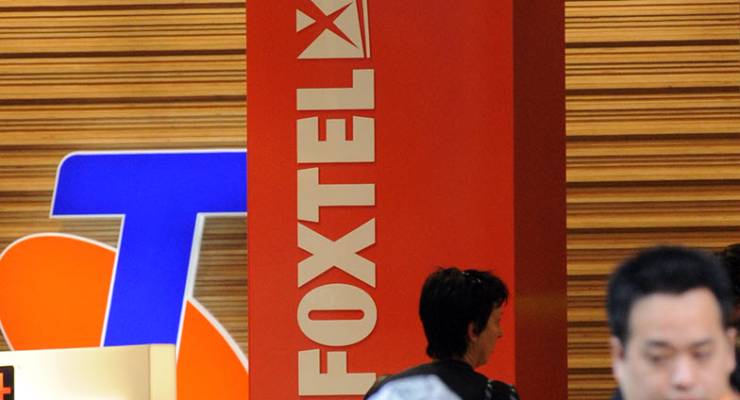
In the year since the News Corp-Telstra divorce at Foxtel, the telco has made hay, building its own subscription TV business to be the largest in the country in terms of user numbers. Telstra has grown its Telstra TV and Live Pass sports streaming in the past year at rates of up to 80%, while Foxtel has stagnated since it was absorbed into News Corp on April 3 last year.
In the breakup, Telstra’s Foxtel stake was cut to 35%, but that freed Telstra up to take a more aggressive stance on building its subscriber base, especially for sports streaming to small devices such as phones and tablets.
The move has been so successful that it now has more than 4 million subscribers between its services — 1.1 million more than Foxtel’s 2.9 million broadcast and streaming service subscribers. Telstra has built those numbers despite its Telstra TV business losing Foxtel subscribers after the split.
Telstra TV has 1.41 million users and Live Pass has more individual users than Foxtel — 2.59 million to Foxtel’s 2.5 million broadcast subscribers. Foxtel’s sports streaming service, which launched last year, had 115,000 subscribers at February 5, a figure boosted by a special price campaign for February.
Telstra TV also allows users to subscribe to Foxtel through its service, but it lost 18,000 of its Foxtel subscribers in 2017-18 — a dropout rate of 50%. Still Telstra said that despite the exit of those Foxtel subscribers, the number of its Telstra TV devices on issue rose 9.4% (or 122,000) over 2018, which again makes a mockery of the upbeat talk from News Corp and Foxtel about the claimed success of their streaming service Kayo.
This is an important point because Telstra is Foxtel’s most important customer and if the number of exits is rising for the telco, that means more people dropped Foxtel than took it up among the 122,000 new Telstra TV users. It’s also a sign of what is happening elsewhere in Foxtel’s wider subscriber base.
Every full service Foxtel subscriber who moves to the lighter Foxtel Now or Kayo platforms represents the cannibalisation of the broadcast subscriber base, which is still Foxtel’s most important asset. Clearly Foxtel subscribers are not being replaced at the same rate among the Telstra TV customers so its churn (the loss of existing broadcast subscribers) is concentrated in its own subscriber base and therefore a much higher figure than the 15.6% that Foxtel reported for the December 2018 half.
And finally the big jump in Telstra Live Pass users across 2018 — around 80% — means that Foxtel faces an uphill slog to ask its existing subscribers to pay for its Kayo service. The 2.59 million people with Live Pass are using it as part of their Telstra mobile packages (and paying for it that way, or being subsidised) and therefore don’t really feel they are paying extra as they would if they took up the Kayo service for $25 a month or $300 a year.
Kayo’s price is less than half the average monthly cost of a full Foxtel package or the Foxtel Now streaming service. That means to retain a customer and sell them Kayo, the customer has to be convinced to pay between $75 and $80 a month (which is around the current and falling average revenue per user of $78). If a non-subscriber buys Kayo, it will be virtually impossible for Foxtel to upsell them to more services unless they cut prices.
In August, Telstra reported a 58% jump in customers streaming sports games over the winter season, and last year won shared digital rights to Football Federation of Australia games for five years.
Telstra competitor Optus’ own sports streaming service hasn’t released numbers, but its exclusive rights to the English Premier League and 2018 World Cup, announced last year, was disastrous — with previous rights-holder SBS called in to broadcast all World Cup matches. The Optus services repeatedly crashed as users tuned in to watch games early in the tournament.
Worldwide, the cost of sports broadcast rights have been increasing as traditional broadcasters try to keep live sport, one of the few formats that delivers ratings. But as the Telstra numbers show, streaming is increasing too, and online streaming services are trying to spread their markets, notably Amazon Prime in the US and UK, which has now also launched in Australia.









I can see another multi million $ gift to Foxtail.
Only if it happens in the next fews weeks. Otherwise, too late.
I am not surprised people are dropping Foxtel. I was astonished to find that there were advertisements in the movies on Foxtel pay TV. Seriously? Not on Netflix, or Stan.
And the pricing structure is absurdly expensive. You have to select multiple packages to get what you want but along with that you get an enormous amount of stuff you don’t want. And the structure is such that a normal person must select many packages to get the mix they want.
It is designed to gouge the maximum amount of money out of each subscriber.
And lastly the money goes to Murdock. That’s a reason to unsubscribe by itself.
As Neil Postman noted 40yrs ago, amusing ourselves to death.
What does this service offer and what is the cost can I watch it in tv